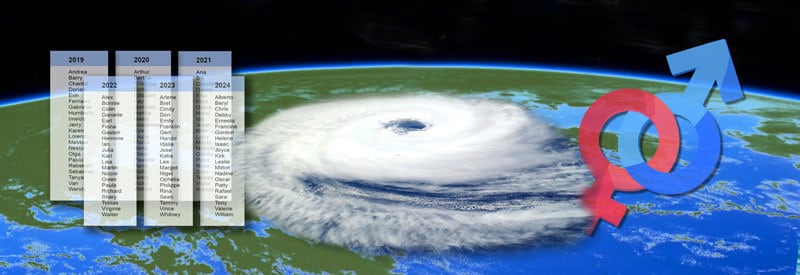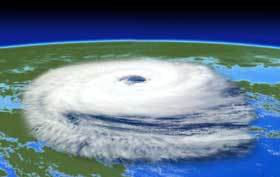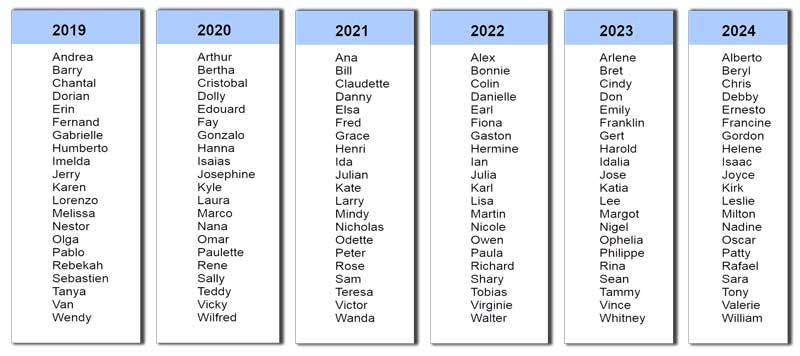Why Hurricanes Were Assigned Female Names In The Past

Many readers will be well aware of what a hurricane is and the many dangers it poses. What may not be that well known, though, is the practice of assigning female names to hurricanes until fairly recently.
In 1953, the US National Weather Service adopted the practice of assigning female names to hurricanes to avoid confusion with other storms. It copied the ancient mariner tradition of dedicating ships to goddesses, and the vessels were also seen as mother figures by ship captains and sailors.
Especially in the United States, you don't have to think too hard to remember hurricanes that were especially devastating in recent times. Names like Katrina, Harvey, and Sandy immediately springs to mind. And these just occurred during the early part of this century.
This leads us to the question as to why these storm systems get named after humans, and more specifically, given female names up till recently.
The answer to both questions is quite logical and makes sense if you look at the reasoning behind the decision to give them human names. To make sense of it all, we will need to go back in time and take a quick history lesson.
Why Were Hurricanes Named After Females?
It will be best to address the elephant in the room first. Especially in today's politically correct times, there are most probably a considerable amount of women who don't appreciate the fact that a violent, destructive storm always used to get a female name.
The practice of attributing female names to hurricanes was a common practice until recent times. Even today, although this is coincidental, some destructive hurricanes still have some female names attached to them. (Think of hurricanes Katrina and Sandy.)
The practice dates back centuries and is rooted in maritime customs. In ancient times, sailors used to dedicate ships to goddesses, and in recent centuries, they were seen as mother figures by ships' captains and mariners.
The image of a ship as a vessel protecting her cargo like a nurturing mother also played a role. As a result, it was common for captains and naval commanders to not only name their ships after a woman but also to refer them as "her" or "she."
Before 1950, hurricanes were named according to their latitude-longitude numbers, which turned out to be complicated and confusing for people to tell hurricanes apart. At some point, specifically in the West Indies, these tropical storms were even named after saints.
Experts soon realized that using an actual person's name made hurricanes easier to remember and less confusing to tell apart. After trying a system that used the phonetic alphabet to name storms in 1950, it was abandoned due to a fear of repetitive names.
In 1953 the National Weather Service adopted the practice of naming hurricanes after women, copying the method traditionally used by naval meteorologists, which roots we explained at the start of this section.
(The system was revised again in 1979 when male names were incorporated into the naming process. More on the adoption of the various systems in the next section.)
It only becomes clear when you look back in history, why female names were so closely connected with hurricanes and cyclones. The fact that these storms always originate over the warm waters of the Subtropics, further explains the connection with maritime practices.
How Do Hurricanes Get Their Names?
Parts of the history that lead to the creation of the current system we use for naming hurricanes were already touched on in the previous section while explaining the use of female names to identify these storms.
A Short History Of Hurricane Naming

The best way to understand how the current naming system was shaped is to look at the defining dates in history when different processes got introduced, which lead to the internationally recognized procedure currently run by the World Meteorological Organization:
Pre 1900s
For centuries, prior to the 1900s, hurricanes were named after saints, specifically in regions surrounding the West Indies, as mentioned earlier in the post. Two noteworthy hurricanes are Hurricane Santa Ana and San Felipe, both of which hit Puerto Rico in the 1800s.
Early 1900s
During the 1890s and early 1900s, an Australian meteorologist by the name of Clement Wragge was credited as the first individual to started using women's names to identify tropical cyclones.
(A tropical cyclone is the umbrella term used to describe all tropical storms, from a tropical depression to hurricanes and typhoons. If you want to find out more about the difference between the different types of tropical storms, you can get more information in this article.)
1950
The trend to use female names continued to grow, while the more confusing system of using "latitude-longitude numbers" to name hurricanes was still used but more limited to scientific communities.
The advantage of using easy-to-remember human names gained popularity. This lead to the United States National Hurricane Center adopting a formal naming system in 1950, based on the military's phonetic alphabet. (For example, Able, Baker, and Charlie.)
1953
The phonetic alphabet system was limited, though. It ran the risk of reusing some names in too short a period of time, so it was revised to avoid repetitive naming.
The revised system was introduced in 1953 and used female names in the Latin alphabet. The decision to use female names was based on the method used by naval meteorologists. In turn, they adopted the age-old habit of mariners to assign female names to objects.
1979
In 1979, this setup had another noteworthy revision with the inclusion of male names with those of females. The National Hurricane Center also doesn't control the naming system, since the procedure is regulated by the World Meteorological Organization.
It is this procedure that is firmly controlled by the WMO, which is currently followed worldwide, which we will discuss in more detail in the next session.
The WMO Hurricane Naming System
Today, the World Meteorological Organization has strict control over the naming of hurricanes, which is adhered to by the vast majority of national weather services globally.

The illustration above shows the full list of names allocated to hurricanes from 2019 - 2024. Click on the image for a larger view.
In a nutshell, the system consists of 6 lists of names, each containing 21 names in alphabetical order. One list is used each year, with the following list used the next. This procedure continues for six years until the whole process starts all over again.
Each list uses the Latin alphabet, with both male and female names used in alphabetical order. Only 21 names are used since the letters Q, U, X, Y, and Z are excluded for obvious reasons.
(Hurricanes occurring over the West Coast of the United States use 24 letters of the alphabet, sins only the letters Q and U get excluded.)
If more than 21 storms occur during a year, the Greek alphabet is used to add additional names to the list.
When merited, some hurricane names are permanently retired from the system. It happens when a storm is so severe that it caused widespread destruction and loss of life, making its reuse potentially sensitive. This decision gets made during the annual meeting of the WMO.
It is important to note that the system used for naming hurricanes discussed in this article is mainly applicable to the North American region.
Other parts of the world, especially in the Southern Hemisphere, use their own systems. However, the majority of them use a variation of the model described in this post, utilizing a certain number of lists rotated every few years and also use names in alphabetical order.
Conclusion
As you probably concluded from reading, the current system we use to name hurricanes is not just efficient and practical but also easy to remember for the average observer.
Although the system has been updated and revised to include male names in 1971, it is clear from looking back through history how the connection between hurricanes and female names got established in the first place.
The primary aim of this article was to explain the process through which hurricane names got chosen, where they originated from, and why they were given female names in the past.
Never miss out again when another interesting and helpful article is released and stay updated, while also receiving helpful tips & information by simply clicking on this link .
Until next time, keep your eye on the weather!
